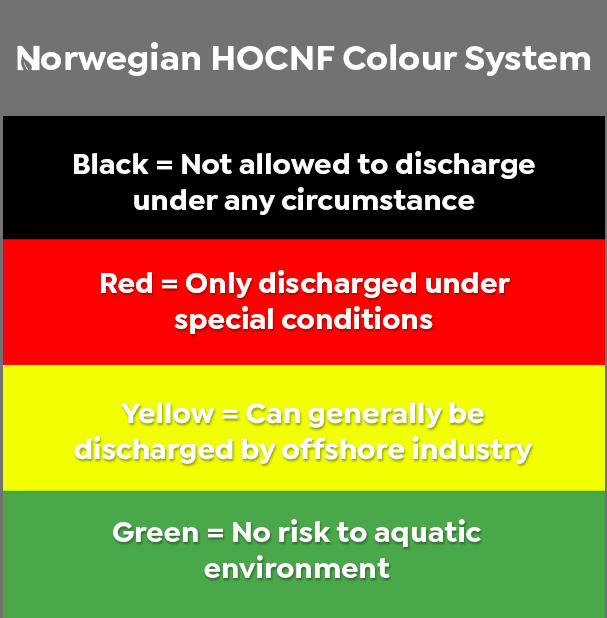Everything you need to know about HOCNF in 3 minutes
HOCNF = Harmonized Offshore Chemical Notification Format
a NEMS iNsight by Anette Jæger
A HOCNF is a document that tells you something about how a chemical is affecting marine life. It contains tests for how the substances present in the product will bioaccumulate, biodegrade and how toxic they are. From the results of these tests, the chemical will get a classification. The classification systems vary a little depending on in what country you are registering the HOCNF.
In Norway a colour system is used, where green substances pose no risk to the aquatic environment, yellow are not that bad and can be discharged by the offshore industry, (some sub-categories of yellow are treated as red), red can only be discharged under special conditions, and black is not allowed to discharge under any circumstances.

Here is a link to the Norwegian “Regulations relating to conducting petroleum activities” also known as “The Activities regulations”, section 62 and 63 are related to HOCNF and testing/categorization of chemicals on the Norwegian shelf.
HOCNFs are also being used in other countries related to operations in the North Sea and North East Atlantic. NEMS Chemicals is also used by authorities and operators in Denmark. There are also opportunities for other countries to implement NEMS Chemicals.
If you are a chemical supplier or an Oil Operator in the North Sea/North East Atlantic check out our product sheets by pressing one of the buttons below.
What is the HOCNF used for?
A HOCNF is used to classify chemicals so that you know how it will impact on the marine environment. The Norwegian government want companies operating on the Norwegian continental shelf to evaluate all chemicals they use offshore. When an operator plans an operation, they are required to apply to the Norwegian Environmental Agency to use chemicals needed for the operation. The Norwegian Environmental Agency will evaluate the application and give approval to go through with the operation if chemicals planned used are reasonable and are documented with HOCNFs, and of course other relevant information required that is not connected to HOCNFs.
The HOCNF form
What is the HOCNF form supposed to tell us:
- What is the product going to be used for?
- Exactly what is the product made of?
- Density of the product, will it float, dissolve or sink in sea water?
- Will the substances in the product bio accumulate?
- Will the substances in the product biodegrade?
- Are the substances in the product toxic to algae, crustacean, fish or the sediment?
The HOCNF form itself looks pretty simple at first glance. Our experience is that there are a number of ways to misinterpret and fill in erroneous information. Over the past 20+ years NEMS have helped customers to register and perform QA on HOCNF data so that it is in conformity with Norwegian rules and regulations. In 2008 NEMS Chemicals® was released, this is a tool where chemical suppliers can register all their HOCNF data. The system is built so that it´s easy to fill out the form, and if you struggle with filling out the form, we will help you do it. We can also help you do the whole registration if needed. Contact us if you want to register a HOCNF or you need more information.
Bioaccumulation
Bioaccumulation refers to the accumulation of substances in the environment before they are taken in by the first organism in a food chain. An example is heavy metals that will accumulate and end up in the fish.
Biodegradation
Biodegradation is the chemical breakdown of materials by a physiological environment. Organic material can be degraded aerobically with oxygen, or anaerobically, without oxygen. The HOCNF test is aerobic. Biodegradable matter is generally organic material such as plant and animal matter and other substances originating from living organisms, or artificial materials that are similar enough to plant and animal matter to be put to use by microorganisms.
Aquatic toxicity
Aquatic toxicity testing submerges key indicator species of fish or crustacean to certain concentrations of a substance in their environment to determine the lethality level. Fish are exposed for 96 hours while crustacea are exposed for 48 hours. It is tested how algae are affected after 72 hours of exposure, and in some instances, it is tested how the chemical is affecting the sediment, and that goes on for 10 days.

